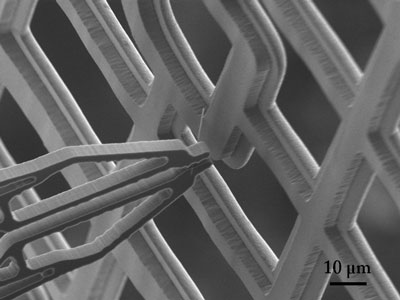Nanomanipulation: Precise Control at the Nanoscale
What is Nanomanipulation?
Nanomanipulation is the process of precisely controlling and manipulating matter at the nanoscale, typically involving the use of specialized tools and techniques. It enables researchers to interact with individual atoms, molecules, and nanostructures, allowing them to build, modify, and characterize nanoscale systems with unprecedented precision.

Key Techniques in Nanomanipulation
Several techniques have been developed to enable nanomanipulation, each with its own advantages and applications:
Scanning Probe Microscopy (SPM)
Scanning Probe Microscopy techniques, such as atomic force microscopy (AFM) and scanning tunneling microscopy (STM), use sharp probes to image and manipulate individual atoms and molecules on surfaces. The probes can be used to apply forces, electric fields, or chemical interactions to move, deform, or modify nanostructures with sub-nanometer precision.
Optical Tweezers
Optical tweezers use focused laser beams to trap and manipulate small particles, such as nanoparticles, biomolecules, and even individual atoms. The optical forces generated by the laser can be used to move, rotate, and assemble nanostructures in three dimensions, enabling the construction of complex nanoscale systems.
Magnetic Tweezers
Magnetic tweezers use magnetic fields to manipulate magnetic nanoparticles or magnetically labeled biomolecules. By applying controlled magnetic forces, researchers can study the mechanical properties of biomolecules, such as DNA and proteins, and investigate their interactions and conformational changes at the single-molecule level.
Nanoscale Robotic Systems
Nanoscale robotic systems, also known as nanorobots or nanomanipulators, are miniaturized devices that can be programmed to perform specific tasks at the nanoscale. These systems can be based on MEMS (microelectromechanical systems) or NEMS (nanoelectromechanical systems) technologies and can be used for nanoscale assembly, nanofabrication, and nanoscale surgery.
Applications of Nanomanipulation
Nanomanipulation has a wide range of applications across various fields, including:
Nanomaterials Synthesis and Assembly
Nanomanipulation techniques can be used to synthesize and assemble nanomaterials with precise control over their size, shape, and composition. This includes the fabrication of nanoparticles, nanowires, and 2D materials, as well as the assembly of these building blocks into functional nanodevices and nanosystems.
Nanoelectronics and Nanophotonics
Nanomanipulation enables the fabrication and characterization of nanoelectronic and nanophotonic devices, such as single-electron transistors, quantum dots, and nanoscale waveguides. By controlling the position and arrangement of individual atoms and molecules, researchers can create novel devices with enhanced performance and new functionalities.
Nanomedicine and Nanobiotechnology
Nanomanipulation techniques are used to study biological systems at the single-molecule level, enabling the investigation of biomolecular interactions, conformational changes, and mechanical properties. This knowledge can be applied to develop targeted drug delivery systems, nanoscale biosensors, and advanced diagnostic tools for personalized medicine.
Fundamental Science
Nanomanipulation allows researchers to explore the fundamental properties of matter at the nanoscale, providing insights into the behavior of individual atoms, molecules, and nanostructures. This knowledge is essential for advancing our understanding of nanoscale phenomena and developing new theories and models to describe them.
Challenges and Future Perspectives
Despite the remarkable progress in nanomanipulation techniques, several challenges remain to be addressed. One of the main challenges is the scalability and throughput of nanomanipulation processes. Many current techniques are limited to small-scale, lab-based experiments and require significant time and effort to manipulate individual nanostructures.
Future research in nanomanipulation will focus on developing high-throughput, automated systems that can manipulate and assemble large numbers of nanostructures in parallel. The integration of machine learning and artificial intelligence techniques will enable the development of smart nanomanipulation systems that can adapt to different tasks and environments.
Another key challenge is the development of non-invasive and non-destructive nanomanipulation techniques that can preserve the integrity and functionality of the manipulated nanostructures. This is particularly important for biological applications, where the manipulation of delicate biomolecules and living systems requires gentle and precise handling.
As nanomanipulation techniques continue to advance, they will open up new opportunities for the design and fabrication of complex nanoscale systems with unprecedented control and precision. This will have far-reaching implications for fields ranging from materials science and nanoelectronics to medicine and biotechnology, enabling the development of transformative technologies that can address global challenges and improve human well-being.
Further Reading
International Journal of Nanomanufacturing
, Review of nanomanipulators for nanomanufacturing
Journal of Physical Chemistry B, Nanomanipulation of Individual DNA Molecules
